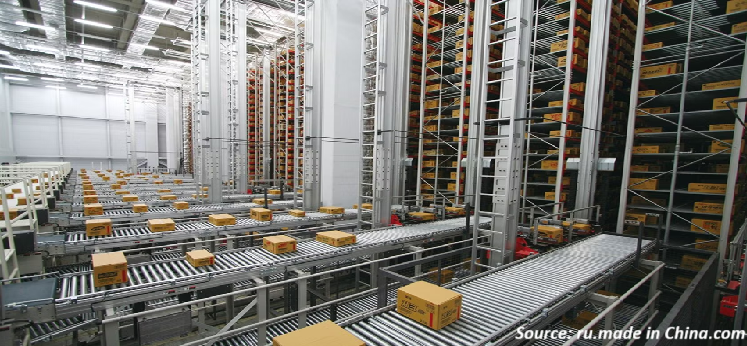
Sleeving Machine Market by Type (Shrink, Stretch, Rotary, Linear, Roll-Fed Labeling, and Others), by Automation Level (Automatic, Semi-Automatic, and Others), and by End-Users (Food and Beverage, Pharmaceuticals, Cosmetics and Personal Care, Chemical, Automotive, and Others)– Global Opportunity Analysis and Industry Forecast, 2025-2030
US Tariff Impact on Sleeving Machine Market
Trump Tariffs Are Reshaping Global Business
Sleeving Machine Market Overview
The global Sleeving Machine Market size was valued at USD 3.15 billion in 2024 and is predicted to reach USD 3.26 billion by the end of 2025. The industry is predicted to reach USD 3.88 billion by 2030 with a CAGR of 3.5% from 2025 to 2030.
The sleeving machine market is evolving rapidly, driven by automation, sustainable packaging, and multi-format adaptability. Key market trends include increased demand for high-speed sleeving lines, integration of AI and IoT for real-time monitoring, and a focus on eco-friendly packaging solutions. Among the main growth drivers are the rising demand in the food and beverage sectors, stringent labeling regulations, and advancements in packaging automation. However, challenges such as high capital investment and a lack of skilled technicians persist. Meanwhile, the integration of AI-driven automation creates an opportunity for market growth.
Rising Growth of Food & Beverage Industry Fuels the Market Growth
The growing consumption of packaged foods and beverages continues to be a major driver for sleeving machine manufacturers. Companies like Eliter Packaging Machinery have launched high-speed automatic sleeving systems to meet the surge in demand from beverage bottlers and dairy producers. These machines offer precise and consistent label application, essential for maintaining branding and compliance in high-throughput environments.
Technological Automation in Sleeving Machines Drives the Market Growth
Automation remains a central growth engine, enabling faster production speeds and consistent labeling across complex formats. Industry leaders are embedding remote diagnostics into sleeving lines. For example, Delta Electronics has incorporated automation controls in their packaging systems to streamline operations and minimize downtime. This boosts efficiency and enhances compliance with industry standards, supporting long-term competitiveness.
Sustainability and Eco-Friendly Packaging Boosts the Market Growth
Growing environmental concerns are pushing manufacturers toward fiber-based and recyclable packaging solutions. Machines designed to handle sustainable materials are seeing increased adoption. For instance, Kiefel’s development of fiber thermoforming machines is shaping a market shift towards cellulose-based sleeving. This trend aligns with ESG initiatives and meets evolving consumer expectations around green packaging.
High Capital Investment Hinders the Sleeving Machine Market Expansion
One of the primary restraints is the high upfront cost associated with installing advanced sleeving systems. Small and mid-sized enterprises (SMEs) often find these investments difficult to justify, particularly in regions with cost-sensitive markets. Custom-built machinery and automation add to the initial expenditure, slowing down adoption despite the long-term benefits.
Integration of AI-Driven Automation Creates Opportunity for Market Growth
The integration of AI-driven automation in sleeving machines, which enhances operational efficiency and reduces human intervention. AI-enabled systems can detect sleeve misalignments, optimize material usage, and adjust machine parameters in real time to meet dynamic production demands. This intelligent automation not only boosts productivity but also aligns with sustainability goals by minimizing waste. As a result, companies adopting such smart technologies are well-positioned to capture a larger market share in these rapidly evolving regions.
For instance, in 2023, Eliter Packaging Machinery launched its MultiWrap high-speed sleeving machine, engineered for emerging markets with space constraints and growing multipack requirements. This launch reflects a rising trend of adaptable automation technologies designed to support regional manufacturers in scaling efficiently.
Market Segmentations and Scope of the Study
The sleeving machine market report is segmented on the basis of type, automation level, end-users, and region. On the basis of type, the market is divided into shrink, stretch, rotary, linear, roll-fed labeling, and others. On the basis of automation level, the market is classified into automatic, semi-automatic, and others. On the basis of end-users, the market is segmented into food and beverage, pharmaceuticals, cosmetics and personal care, chemical, automotive and others. Regional breakdown and analysis of each of the aforesaid segments include regions comprising North America, Europe, Asia-Pacific, and RoW.
Geographical Analysis
In North America, the sleeving machine market is witnessing steady growth, primarily driven by stringent labeling regulations, labor cost concerns, and increasing demand for flexible packaging in food and beverage applications. The U.S. and Canada are investing heavily in automated sleeving and shrink label applicators that improve throughput and ensure regulatory compliance. Manufacturers are prioritizing equipment with smart diagnostics and minimal downtime to meet rising consumer expectations for sustainability and speed. Companies such as Accraply and Delta have introduced advanced sleeve seaming and applicator systems, reflecting the region’s commitment to high-performance machinery that aligns with ESG goals and modern packaging trends.
Europe's sleeving machine industry is evolving rapidly, fueled by the EU's circular economy targets and a consumer shift toward eco-conscious packaging. Countries such as Germany, France, and Italy are leading in the adoption of fiber-based, recyclable, and biodegradable sleeve materials. This demand for sustainable solutions is reshaping the design and engineering of sleeving machines to handle non-plastic substrates without compromising efficiency. Major European players are investing in hybrid sleeving systems compatible with cellulose-based packaging formats. Additionally, frequent participation in trade expos such as Ipack-Ima signals growing interest in flexible, modular equipment that caters to evolving product portfolios and sustainability regulations.
Asia-Pacific is emerging as the most dynamic region in the global sleeving machine market. Countries like China, India, Japan, and South Korea are experiencing rapid industrialization and expanding FMCG, pharmaceutical, and dairy sectors. This growth is creating strong demand for compact, high-speed sleeving machines tailored to high-volume, cost-sensitive operations. Notably, in 2023, Eliter Packaging Machinery launched a MultiWrap sleever specifically for multipack applications in Asia’s emerging markets, highlighting regional innovation and responsiveness. The rising trend of local automation, combined with government incentives for food safety and industrial modernization, is further boosting the region’s market share and long-term growth potential.
In the Rest of the World (RoW), encompassing Latin America, the Middle East, and Africa, the sleeving machine market is gradually gaining traction amid expanding manufacturing bases and improved trade logistics. Countries such as Brazil, South Africa, and the UAE are witnessing increased investments in food packaging, pharmaceuticals, and cosmetics, where visually distinctive, tamper-evident sleeving plays a key role. However, market penetration remains uneven due to limited automation infrastructure and budget constraints. Global manufacturers are responding by offering scalable and energy-efficient machines to cater to small and mid-sized enterprises in these regions, unlocking previously untapped opportunities and contributing to the industry's global footprint.
Strategic Moves Shaping the Sleeving Machine Industry
Leading manufacturers in the global sleeving machine industry are embracing a mix of strategic expansions, product innovations, and digital integration to stay ahead in a competitive and evolving packaging landscape. Companies such as Eliter Packaging Machinery, Bhagwati Pharma, and Accraply are investing in high-speed, multi-functional sleevers designed to address the growing demand for efficiency, sustainability, and customization. For instance, Eliter’s 2023 launch of the MultiWrap Automatic Sleeving Machine showcases a shift toward compact designs that cater to multipack applications in fast-moving consumer goods (FMCG). Similarly, Magic Special Purpose Machineries has introduced shrink-sleeve applicators with modular components that enhance flexibility for diverse production lines. These advancements help boost market share in segments where packaging speed, hygiene, and precision are mission-critical.
However, challenges persist, particularly in the form of fluctuating raw material costs, rising energy prices, and the integration complexities of automation and AI-driven diagnostics in legacy systems. Furthermore, manufacturers must navigate diverse regulatory requirements across geographies, which demand custom engineering and localized service support. Despite these hurdles, opportunities remain robust. Emerging markets in Southeast Asia, Latin America, and Africa are investing in food safety, pharmaceutical packaging, and export-quality consumer goods, creating a fertile ground for tailored sleeving solutions. Additionally, the industry’s push toward sustainable packaging is encouraging R&D in biodegradable sleeve materials and eco-friendly machine configurations. Companies that align operational strategies with ESG benchmarks, while ensuring cost efficiency and compliance, are best positioned to lead in both industry size expansion and long-term growth potential.
Key Benefits
-
The report provides quantitative analysis and estimations of the sleeving machine market from 2025 to 2030, which assists in identifying the prevailing market opportunities.
-
The study comprises a deep dive analysis of the sleeving machine market including the current and future trends to depict prevalent investment pockets in the market.
-
Information related to key drivers, restraints, and opportunities and their impact on the sleeving machine market is provided in the report.
-
Competitive analysis of the players, along with their market share is provided in the report.
-
SWOT analysis and Porters Five Forces model is elaborated in the study.
-
Value chain analysis in the market study provides a clear picture of roles of stakeholders.
Sleeving Machine Market Key Segments
By Type
-
Shrink
-
Stretch
-
Rotary
-
Linear
-
Roll-Fed Labeling
-
Others
By Automation Level
-
Automatic
-
Semi-Automatic
-
Others
By End-Users
-
Food and Beverage
-
Pharmaceuticals
-
Cosmetics and Personal Care
-
Chemical
-
Automotive
-
Others
By Region
-
North America
-
The U.S.
-
Canada
-
Mexico
-
-
Europe
-
The UK
-
Germany
-
France
-
Italy
-
Spain
-
Denmark
-
Netherlands
-
Finland
-
Sweden
-
Norway
-
Russia
-
Rest of Europe
-
-
Asia Pacific
-
China
-
Japan
-
India
-
South Korea
-
Australia
-
Indonesia
-
Singapore
-
Taiwan
-
Thailand
-
Rest of Asia Pacific
-
-
RoW
-
Latin America
-
Middle East
-
Africa
-
Key Players
-
Allen Plastic Industries Co. Ltd.
-
Cama Group
-
Brothers Pharmach Pvt. Ltd.
-
Boss Packaging Solutions Pvt Ltd.
-
ProMach Inc.
-
Jet Pack Machines Private Ltd.
-
Harikrushna Machines Pvt. Ltd.
-
PDC International Corporation
-
Sleeve Technology
-
ELITER Packaging Machinery
-
Shree Bhagwati Labelling Technologies
-
Renuka Packaging Machines & Automations
-
Barry-Wehmiller Companies
-
Accutek Packaging Company, Inc.
-
ProMach Inc.
REPORT SCOPE AND SEGMENTATION:
|
Parameters |
Details |
|
Market Size in 2024 |
USD 3.15 Billion |
|
Revenue Forecast in 2030 |
USD 3.68 Billion |
|
Growth Rate |
CAGR of 3.5% from 2025 to 2030 |
|
Analysis Period |
2024–2030 |
|
Base Year Considered |
2024 |
|
Forecast Period |
2025–2030 |
|
Market Size Estimation |
Billion (USD) |
|
Growth Factors |
|
|
Countries Covered |
28 |
|
Companies Profiled |
15 |
|
Market Share |
Available for 10 companies |
|
Customization Scope |
Free customization (equivalent up to 80 working hours of analysts) after purchase. Addition or alteration to country, regional, and segment scope. |
|
Pricing and Purchase Options |
Avail customized purchase options to meet your exact research needs. |

















 Speak to Our Analyst
Speak to Our Analyst





















